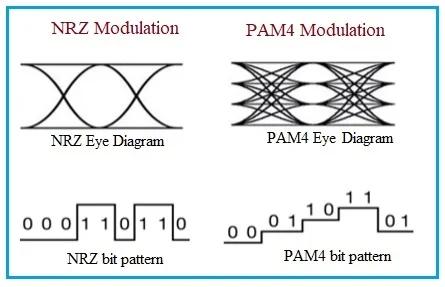Understanding PAM4 Modulation: Principles, Advantages, and Disadvantages
Advertisement
The term PAM4 stands for Pulse Amplitude Modulation with four levels. It is a modulation scheme used in digital communication to transmit data over a communication channel. In PAM4, each symbol represents four different signal levels, allowing for the transmission of multiple bits per symbol.
This is in contrast to traditional binary modulation schemes like PAM2 or NRZ, where each symbol represents two signal levels.

In PAM4, the four levels can be represented as -3, -1, +1, and +3 (or 0, 1, 2, and 3 in some cases). Each level corresponds to a specific combination of two bits, allowing for a higher data rate compared to binary modulation. This makes PAM4 particularly useful for increasing the data-carrying capacity of communication systems.
The figure depicts PAM4 and NRZ eye diagrams and bit patterns. PAM4 is commonly used in high-speed communication systems such as optical fiber communication, where the demand for higher data rates is significant. It is utilized in standards like 100 Gigabit Ethernet (100GbE) and 400 Gigabit Ethernet (400GbE) for data center and high-performance computing applications.
PAM4 modulation enables higher data rates by transmitting more bits per symbol, but it also poses challenges in terms of signal processing and error correction due to the increased complexity of decoding multiple bits from a single symbol. Let us explore the advantages and disadvantages of PAM4 modulation in more detail after understanding its need.
Why is PAM4 Needed?
PAM4 modulation is used in communication systems for several reasons, addressing the growing demand for higher data rates, improved spectral efficiency, and efficient utilization of available bandwidth. Here are some key reasons why PAM4 modulation is needed:
- To address the growing global demand for bandwidth in the existing network infrastructure which was not fulfilled by traditional NRZ signals, PAM4 has been introduced. Refer to NRZ vs PAM4 for the difference between NRZ and PAM4 modulation types.
- To meet high data rate requirements without increasing the symbol rate for high-speed communication systems.
- PAM4 is utilized in standards like 100 Gigabit Ethernet (100GbE) and 400 Gigabit Ethernet (400GbE) for high-speed data transmission in data center environments.
- PAM4 modulation can be implemented in existing infrastructure without requiring a significant overhaul.
- PAM4 modulation offers a cost-effective solution as it allows increased throughput without the need for a proportional increase in the complexity of the overall system.
- To meet the higher transmission efficiency requirements of 5G enterprise and carrier networks.
Advantages of PAM4 Modulation
Following are the benefits or advantages of PAM4 modulation:
- PAM4 allows for higher data rates compared to traditional binary modulation schemes because each symbol represents more than one bit.
- PAM4 achieves a higher spectral efficiency by transmitting more bits per symbol which is essential especially in applications like optical fiber communication.
- The higher information density of PAM4 enables the transmission of more data within the same bandwidth, leading to a more efficient use of the communication channel.
- PAM4 drastically reduces construction and R&D costs as it requires fewer mature optical components.
- At the same bit rate, the baud rate of a PAM4 signal is only half that of an NRZ signal, significantly reducing the signal transmission loss in a channel.
Disadvantages of PAM4 Modulation
Following are the drawbacks or disadvantages of PAM4 modulation:
- Decoding multiple bits from a single symbol introduces more complexity in signal processing and error correction algorithms at the receiver.
- PAM4 signals are more susceptible to noise and channel impairments than NRZ.
- PAM4 modulation type requires more power for signal processing and equalization. This impacts the overall power efficiency of the communication system.
- PAM4 signals support shorter transmission reach compared to simple modulation schemes due to increased susceptibility to signal degradation over distance, especially in fiber optic communication.
Conclusion
In summary, while PAM4 offers advantages in terms of higher data rates and spectral efficiency, it comes with challenges such as increased complexity, susceptibility to noise, and potential limitations in transmission distance. The choice of modulation scheme depends on the specific requirements and constraints of the communication system. PAM4 is ideal for various applications including 5G Wireless Communication, SerDes (Serializer/Deserializer) Technology, Coherent Optical Communication, and so on.
Advertisement
 RF
RF



